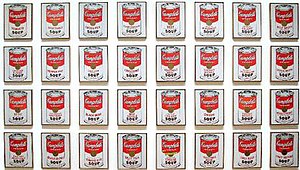Week Three - Robotics and Art
Week Three - Robotics and Art
It’s safe to say that the Industrial Revolution was, well, revolutionary. It completely transformed the way goods were created and the global economy was forced to evolve. Often when discussing the Industrial Revolution, the impact of industrialization and mechanization on art goes unmentioned.
Fast forward a few hundred years and the effects are still clear, perhaps even more apparent.
With a focus on painting and visual art, the idea of mass production goes hand in hand with the pop art movement. The art produced at this time recognized the accessibility of reproduction, particularly on a massive scale. Rather than turn away from it, pop artists embraced it fully. The entire movement was about taking images that already flooded popular culture and try to bring even more attention to them.
Walter Benjamin was not quite so keen on embracing the mechanical. Benjamin, in “The Work of Art in the Age of Mechanical Reproduction”, finds that technological advancements hinder the authenticity of art. Referred to as its “aura”, art’s sense of uniqueness and fullest identity is sacrificed when it engages in mass reproduction, or reproduction in any capacity really.
Most of society falls somewhere between these two frames of mind. Wide release of movies, national broadcasts of television, and international streaming of internet-based content are all consumed by the public without any concern for the “aura” of the work they are experiencing. Other forms of art align more closely with Benjamin’s perspective. Things like theaters and art museums prioritize the authenticity of a piece and the value of a work being the most real version of itself (so to speak). Ultimately, the kind of art and entertainment one prefers decides their point of view on the relationship between mechanization and art.
It’s safe to say that the Industrial Revolution was, well, revolutionary. It completely transformed the way goods were created and the global economy was forced to evolve. Often when discussing the Industrial Revolution, the impact of industrialization and mechanization on art goes unmentioned.
 |
| One of the most famous examples of pop art, Andy Warhol's Campbell's Soup Cans. |
Fast forward a few hundred years and the effects are still clear, perhaps even more apparent.
With a focus on painting and visual art, the idea of mass production goes hand in hand with the pop art movement. The art produced at this time recognized the accessibility of reproduction, particularly on a massive scale. Rather than turn away from it, pop artists embraced it fully. The entire movement was about taking images that already flooded popular culture and try to bring even more attention to them.
Walter Benjamin was not quite so keen on embracing the mechanical. Benjamin, in “The Work of Art in the Age of Mechanical Reproduction”, finds that technological advancements hinder the authenticity of art. Referred to as its “aura”, art’s sense of uniqueness and fullest identity is sacrificed when it engages in mass reproduction, or reproduction in any capacity really.
| Even though it's been reproduced countless times, people come from all over the world to see the Mona Lisa in person. |
 |
| As 2016's top-grossing film, Captain America: Civil War took advantage of mass reproduction and availability. |
Works Cited
Benjamin, Walter. "The Work of Art in the Age of Mechanical Reproduction." Stardom and Celebrity: A Reader (n.d.): 25-33. Web.
Gopnik, Blake. "Andy Warhol's Campbell's Soup Can Paintingss." Artnet News. Artnet News, 12 Oct. 2015. Web. 24 Apr. 2017.
McClintock, Pamela. "Captain America: Civil War - Box Office: 'Captain America: Civil War' Leads 2016 With $1.15B." The Hollywood Reporter. The Hollywood Reporter, 05 Jan. 2017. Web. 24 Apr. 2017.
"'Mona Lisa' Mystery: Was Painting Completed a Decade Later?" Los Angeles Times. Los Angeles Times, n.d. Web. 24 Apr. 2017.
Osterwold, Tilman, and Iain Galbraith. Pop Art. Köln: Taschen, 2015. Print.
Comments
Post a Comment